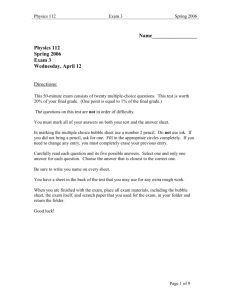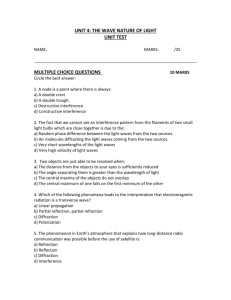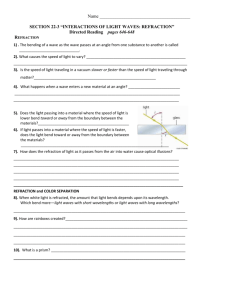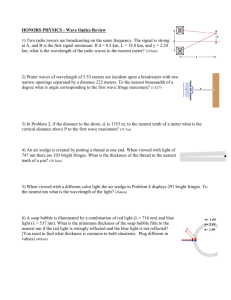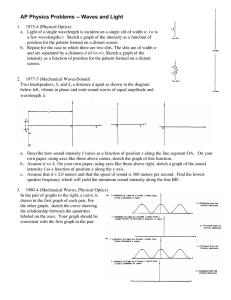AP_Physics_Assignments_files/RAP 06 Lesson 24 Waves Key
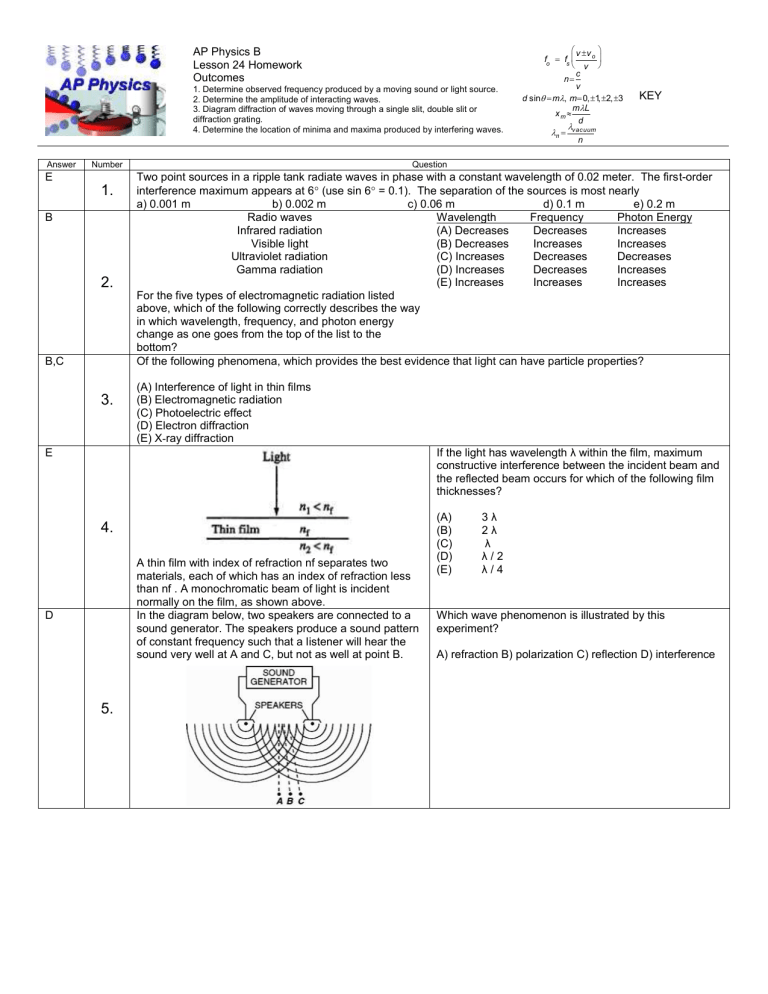
AP Physics B
Lesson 24 Homework
Outcomes
1. Determine observed frequency produced by a moving sound or light source.
2. Determine the amplitude of interacting waves.
3. Diagram diffraction of waves moving through a single slit, double slit or diffraction grating.
4. Determine the location of minima and maxima produced by interfering waves.
f o
f s x
v
v v o
n
c d sin v
m
, m
0,
1,
2,
3 m
L
n m
d v ac uum n
KEY
Answer Number
E
1.
B
B,C
E
D
2.
3.
4.
Question
Two point sources in a ripple tank radiate waves in phase with a constant wavelength of 0.02 meter. The first-order interference maximum appears at 6 a) 0.001 m
(use sin 6 b) 0.002 m
c) 0.06 m
d) 0.1 m e) 0.2 m
Radio waves
Infrared radiation
Visible light
Ultraviolet radiation
Gamma radiation
For the five types of electromagnetic radiation listed above, which of the following correctly describes the way in which wavelength, frequency, and photon energy change as one goes from the top of the list to the bottom?
Wavelength Frequency
(A) Decreases Decreases
(B) Decreases Increases
(C) Increases Decreases
(D) Increases Decreases
(E) Increases Increases
Photon Energy
Increases
Increases
Decreases
Increases
Increases
Of the following phenomena, which provides the best evidence that light can have particle properties?
(A) Interference of light in thin films
(B) Electromagnetic radiation
(C) Photoelectric effect
(D) Electron diffraction
(E) X ray diffraction
A thin film with index of refraction nf separates two materials, each of which has an index of refraction less than nf . A monochromatic beam of light is incident
If the light has wavelength λ within the film, maximum constructive interference between the incident beam and the reflected beam occurs for which of the following film thicknesses?
(A)
(B)
(C)
(D)
(E)
3 λ
2 λ
λ
λ / 2
λ / 4 normally on the film, as shown above.
In the diagram below, two speakers are connected to a sound generator. The speakers produce a sound pattern of constant frequency such that a listener will hear the sound very well at A and C, but not as well at point B.
Which wave phenomenon is illustrated by this experiment?
A) refraction B) polarization C) reflection D) interference
5.
D
6.
As shown in the diagram below, speakers S1 and S2, separated by a distance of 0.50 meter, are producing sound of the same constant frequency. A person walking along a path 4.0 meters in front of the speakers hears the sound reach a maximum intensity every 2.0 meters.
What is the wavelength of the sound produced by the speakers?
A) 4.0 m
B) 0.063 m
C) 10 m
D) 0.25 m
C
B
C
B
D
7.
8.
9.
10.
A car radio is tuned to the frequency being emitted from two transmitting towers. As the car moves at constant speed past the towers, as shown in the diagram below, the sound from the radio repeatedly fades in and out.
This phenomenon can best be explained by
A) reflection B) resonance C) interference D) refraction
Which point is at a position of maximum destructive interference?
A) A
B) B
C) C
D) D
Two wave sources operating in phase in the same medium produce the circular wave patterns shown in the diagram below. The solid lines represent wave crests and the dashed lines represent wave troughs.
Compared to the length of path BP, the length of path AP is
A) 2l longer
B) the same
C) 1 \2 l longer
D) 1l longer
The diagram below represents shallow water waves of wavelength l passing through two small openings, A and B, in a barrier.
The diagram below represents a group of light waves emitted simultaneously from a single source.
The light waves would be classified as
A) neither monochromatic nor coherent
B) both monochromatic and coherent
C) monochromatic, but not coherent
D) coherent, but not monochromatic
11.
The diagram below shows a beam of light entering and leaving a "black box."
The box most likely contains a
A) prism
B) double slit
C) converging lens
D) polarizer
C
B
A
12.
13.
14.
The diagram below shows a parked police car with a siren on top. The siren is producing a sound with a frequency of 680 hertz, which travels first through point A and then through point B, as shown. The speed of the sound is 340 meters per second.
What is the wavelength of the sound produced by the car's siren?
A) 2.3 x 10 -6 m
B) 2.3 x 10 5
C) 0.50 m
D) 2.0 m
m
If the car were to accelerate toward point A, the frequency of the sound heard by an observer at point A would
A) remain the same B) increase C) decrease
The diagram below shows radar waves being emitted from a stationary police car and reflected by a moving car back to the police car.
The difference in apparent frequency between the incident and reflected waves is an example of
A) the Doppler effect
B) refraction
C) constructive interference
D) total internal reflection
D
B
A
D
A
A
15.
16.
The diagram on the right represents the wave pattern produced by a vibrating source moving linearly in a shallow tank of water. The pattern is viewed from above and the lines represent wave crests.
The vibrating tuning fork shown in the diagram below produces a constant frequency. The tuning fork is moving to the right at a constant speed, and observers are located at points
A, B, C, and D.
Which observer hears the lowest frequency?
A) A
B) B
C) C
D) D
Use for 16-19. The source is moving toward point
A) A B) B C) C D) D
17.
18.
19.
20.
The wave pattern is an illustration of
A) the Doppler effect B) interference C) dispersion D) diffraction
Compared to the frequency of the waves observed at point D, the frequency of the waves observed at point B is
A) higher B) lower C) the same
The velocity of the source is increased. The wavelength of the waves observed at point D will
A) increase B) decrease C) remain the same
The driver of a car hears a siren of an ambulance which is moving away from her. If the actual frequency of the siren is 2,000 hertz, the frequency heard by the driver may be
A) 2,000 Hz B) 2,100 Hz C) 4,000 Hz D) 1,900 Hz
1975B4. a. Light of a single wavelength is incident on a single slit of width w. (w is a few wavelengths.) Sketch a graph of the intensity as a function of position for the pattern formed on a distant screen.
1977B5. Two loudspeakers, S1 and S2 a distance d apart as shown in the diagram above, vibrate in phase and emit sound waves of equal amplitude and wavelength
. Assume d << L a. Describe how sound intensity I varies as a function of position x along the line segment OA. Sketch the graph of this function on the axes below.
Answer: Inverse square function
Assume lambda << d On the axes provided below sketch a graph of the sound intensity I as a function of position y along the y axis.
Answer: same as on the screen in problem above
Assume that d = 2 meters and that the speed of sound is 360 meters per second. Find the lowest speaker frequency which will yield the minimum sound intensity along the line BB'.
Lambda is ?. Answer: d=?/2 v=f? f=v/2d f=90Hz
1980B4. In the five pairs of graphs that follow, a curve is drawn in the first graph of each pair. For the other graph in each pair, sketch the curve showing the relationship between the quantities labeled on the axes. Your graph should be consistent with the first graph in the pair.
1984B5. The surface of a glass plate (index of refraction n3 = 1.50) is coated with a transparent thin film (index of refraction n2 = 1.25).
A beam of monochromatic light of wavelength 6.0 x 10 7 meter traveling in air (index of refraction n1 = 1.00) is incident normally on surface S1 as shown above. The beam is partially transmitted and partially reflected. a. Calculate the frequency of the light. C=f? f=3x10 8 /6.0x10
-7 b. Calculate the wavelength of the light in the thin film. n=c/v 1.25=3x10 8 / v
The beam of light in the film is then partially reflected and partially transmitted at surface S2 b. Calculate the minimum thickness d1 of the film such that the resultant intensity of the light reflected back into the air is a minimum.
d1=?/4 since there are 2 phase shifts ?=v/f (v from b) and f from a) ) c. Calculate the minimum nonzero thickness d2 of the film such that the resultant intensity of the light reflected back into the air is a maximum. d2=?/2
1985B5. Light of wavelength 5.0 x 10 7 meter in air is incident normally (perpendicularly) on a double slit. The distance between the slits is 4.0 x 10-4 meter, and the width of each slit is negligible. Bright and dark fringes are observed on a screen 2.0 meters away from the slits. a. Calculate the distance between two adjacent bright fringes on the screen. y=?L/d y=(5.0 x 10
-
7 )(2.0)/ 4.0 x 10 -4
The entire double slit apparatus, including the slits and the screen, is submerged in water, which has an index of refraction 1.3. b. Determine each of the following for this light in water. i. The wavelength ?=?
0
/n OR v=c/n f=c/? ?=v/f (c=speed of light in air; v=speed of light in the medium; ?
0 wavelength in air
; remember that frequency stays the same in any medium) ii. The frequency f=c/?
0 c. State whether the distance between the fringes on the screen increases, decreases, or remains the same. Justify your answer.
1990B6
Y decreases; increase d in the equation and y will decrease
In one section of the pool, there is a thin film of oil on the surface of the water. The thickness of the film is 1.0 X l0 7 meter and the index of refraction of the oil is 1.5. The light source is now held in the air and illuminates the film at normal incidence, as shown above. d. At which of the interfaces (air oil and oil water), if either, does the li ght undergo a 180° phase change upon reflection? Air to oil e. For what wavelengths in the visible spectrum will the intensity be a maximum in the reflected beam? d=?/4 ? in oil (?
oil
=?
air
/n oil
)
1991B6. Light consisting of two wavelengths,
a = 4.4 x 10 7 meter and
b = 5.5 x 10 7 meter, is incident normally on a barrier with two slits separated by a distance d. The intensity distribution is measured along a plane that is a distance L = 0.85 meter from the slits as shown above. The movable detector contains a photoelectric cell whose position y is measured from the central maximum. The first
order maximum for the longer wavelength
b occurs at y = 1.2 x 10 2 meter. a. Determine the slit separation d. d=m?/sin@ b. At what position Ya does the first order maximum occur for the shorter wavelength
a? y a
/?
a
=y b
/?
b
1996B3 (15 points)
Coherent monochromatic light of wavelength
in air is incident on two narrow slits, the centers of which are 2.0mm apart, as shown above. The interference pattern observed on a screen 5.0 m away is represented in the figure by the graph of light intensity I as a function of position x on the screen. a. b.
What property of light does this interference experiment demonstrate? diffraction
At point P in the diagram, there is a minimum in the interference pattern. Determine the path difference between the light arriving at this point from the two slits. Looking at the diagram you can see that path has to be 3/2? longer than the path to the center . OR Use pythagorean c. Determine the wavelength,
, of the light. ?=dx/mL d. Briefly and qualitatively describe how the interference pattern would change under each of the following separate modifications and explain your reasoning. i. The experiment is performed in water, which has an index of refraction greater than 1. compressed, because the wavelength is less due to the slower wave speed in water ii. One of the slits is covered. One slit diffraction pattern iii. The slits are moved farther apart. Compressed pattern; increase d in the equation will show that a.
1998B7 (10 points) A transmission diffraction grating with 600 lines/mm is used to study the line spectrum of the light produced by a hydrogen discharge tube with the setup shown above. The grating is 1.0 m from the source (a hole at the center of the meter stick). An observer sees the first order red line at a distance yr = 428 mm from the hole. a. c.
Calculate the wavelength of the red line in the hydrogen spectrum.
Qualitatively describe how the location of the first order red line would change if a diffraction grating with 800 lines/mm were used instead of one with 600 lines/mm. d=1mm/600 d sin@=m ? tan@=y/L=428/1m @=23
,because of the very small distances the assumption is made that tan@=sin@
c. farther away; notice that if d decreases (more slits per mm) the angle increases.


